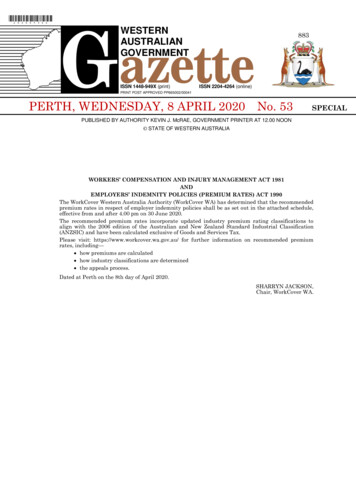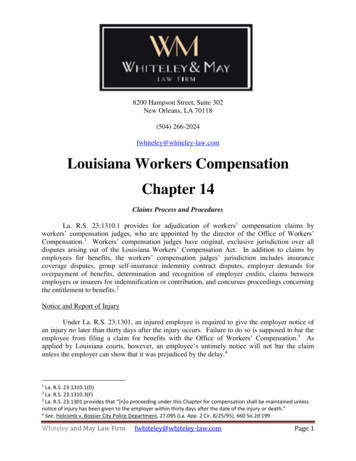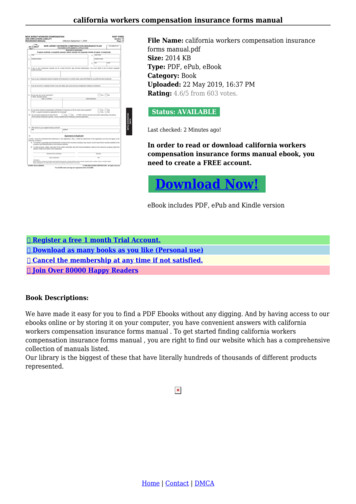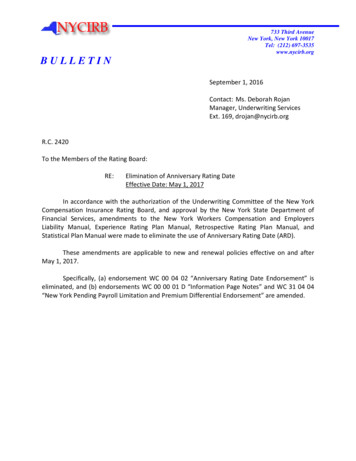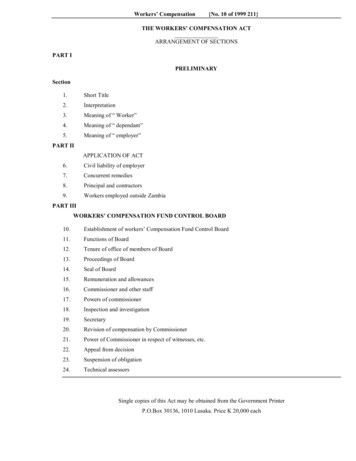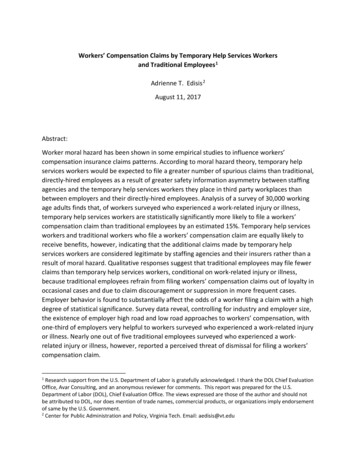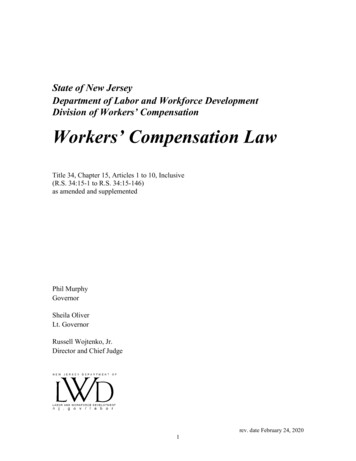
Transcription
a technical note onContractors and Workers’ Compensation
WorkCover WA2 Bedbrook PlaceShenton Park WA 6008Telephone: (08) 9388 5555Facsimile: (08) 9388 5550Advice and Assistance Unit: 1300 794 744TTY (hearing impaired): (08) 9388 5537Website: www.workcover.wa.gov.auAbout WorkCover WAWorkCover WA is the government agency responsible for overseeing theworkers’ compensation and injury management scheme in Western Australia.This includes monitoring compliance with the Workers’ Compensation andInjury Management Act 1981, informing and educating workers, employers andothers about workers’ compensation and injury management, and providing anindependent dispute resolution system.This publication is current at January 2017DisclaimerThis publication contains information regarding workers’ compensation and injurymanagement. It is intended to provide general information only. You should not actor omit to act on the basis of anything contained herein. This brochure should beread in conjunction with the Workers’ Compensation and Injury Management Act1981. You should seek appropriate legal/professional advice about your particularcircumstances.For more information, visit the WorkCover WA website at www.workcover.wa.gov.au.Workers’ compensation legislation is also available from the State Law Publisherwebsite at www.slp.wa.gov.au. 2017 WorkCover Western Australia. All rights reserved
Contractors andworkers’compensationEmployers must ensure workers’compensation insurance is inplace to cover all workers forwork-related injuries.In addition to traditional employeremployee arrangements, contractorsand sub-contractors may also be entitledto workers’ compensation if they aredefined as workers under the Workers’Compensation and Injury ManagementAct 1981 (the Act).It is important for anyone who engagesworkers under contractual workingarrangements to check whether they haveworkers’ compensation obligations underthe Act.This booklet describes how ‘workers’are defined in the legislation and how thecompensation laws are applied in practice.3
DefinitionsWorkerThe Act has both a primary and extendeddefinition of a worker.The primary definition covers those whoare employed under a contract of service- the relationship being one of employeremployee.The extended definition broadens thescope of who is considered as a workerunder the Act to include independentcontractors engaged under a contractfor service where the remuneration theyreceive is in substance for personalmanual labour or services. (The term‘in substance’, is explained later in thisdocument).Deemed WorkersIn some circumstances where acontractor’s workers are under the controland direction of a principal contractor,that principal contractor may also beliable (jointly with the contractor) for thecontractor’s workers.A workers’ compensation liability may alsoarise where a worker is engaged undercontractual arrangements contrived sothat the employer can avoid his or herliabilities under the Act; for example, byrequiring the worker to incorporate (setup their own company) as a condition ofgetting a contract.Working DirectorsA ‘working director’ is a director of acompany who executes work for oron behalf of the company and whoseearnings as a director are in substance forpersonal manual labour or services.4A company must apply to an approvedworkers’ compensation insurer to covertheir working directors. If this action is nottaken, working directors are not coveredfor any claim made by the workingdirector on the company.Some working directors may work in morethan one employment and be employedor engaged directly by some otheremployer. If employed or engaged directly,that other employer may have a liability forthe working director.ImportantJust because a person is describedas self-employed or has an AustralianBusiness Number does not exemptthe person or entity who has engagedthem from any liability for work-relatedinjuries. The provisions of the Act applyregardless of any contract made to thecontrary (section 301). In relation tocontractors, this means that any privatearrangement entered into in relation tocompensation for workplace injury is nulland void if the contractor makes a claimand is considered to be a worker underthe act.
Contract of ServiceA large part of the workforce works undera contract of service including: full-time and part-time workers casuals (working for an employer’strade or business) seasonal and piece workers workers on salary or wages workers supervised and controlledby an employer workers who may be fired by anemployer workers who work for only oneemployer; and workers with set hours of work.Many contractors and sub-contractorsmay also be defined as workers underthe primary definition if they do nothave independence in conducting theiroperations and do not genuinely run anindependent business or enterprise.What the Act saysSection 5 (primary definition):“ “worker” does not include a personwhose employment is of a casualnature and is not for the purpose of theemployer’s trade or business, butsave as aforesaid, means any personwho has entered into or works under acontract of service or apprenticeshipwith an employer, whether by wayof manual labour, clerical work, orotherwise and whether the contractis expressed or implied, is oral or inwriting; ”InterpretationAlthough there is no definitive statementthat can be applied to determine if acontract of service exists, generally it isclear whether a person is working undersuch a contract, i.e. the relationship is oneof employer-employee and the employermust take out workers’ compensation tocover that employee.Defining a worker’s status- contract of serviceThere are a number of factors thatdistinguish workers employed under acontract of service from those employedas independent contractors. No onefactor alone indicates such a contract.Instead the totality of the employmentrelationship must be considered.ControlThe most important indicator of theexistence of a contract of service is thelevel of control over a worker. If the workdone by the worker is subject to thedirection and control of the other person,then an employer-employee relationshipis more likely to be established. However,where the worker agrees only to producea certain result but is not subject tocontrol in actually doing the work then therelationship is likely to be considered asone of principal/independent contractorRemunerationWhere remuneration is paid on the basisof time spent on the job, the relationshipis likely to be a contract of service and therelationship one of employer-employee.Where the contract relates to servicesprovided (i.e. contract for services),remuneration is more likely to depend onresults or levels of production.5
Working hoursWhere the working hours are stipulated in acontract, it infers greater levels of control andsupervision. Coupled with other factors, thismay indicate the existence of a contract ofservice and an employer-employee (worker)relationship.The right to employ othersIf a person is entitled to delegate their workand employ others to do the work for them,then the relationship is more likely to bea contract for service, than a contract ofservice.EquipmentGenerally, the higher the level of material andequipment provided for the worker, the morelikely it is that he or she is employed under acontract of service.TerminationA right to dismiss a worker does not by itselfindicate the contract is a contractof service. However, it is a furtherexample of the right to control a worker andmay indicate that one party has effectivecontrol of the conduct of the work ofanother.Terms of the contractJust because two parties enter into acontract, which says the relationship isone of principal and contractor, does notnecessarily mean that such a relationship isestablished under the Act. If all other factorsindicate the relationship is of another kind,then the parties’ expressed intentions donot alter its true nature. However, where therelationship is ambiguous, then an expressprovision in the contract will bear greatersignificance in law.6
Summary of factors to consider in determining a contract of service: The nature of the work. The extent of any control exercised by the employer. How and on what basis the employee is remunerated. Any obligation to work for defined or regular hours. Who provides tools, equipment and fuel. How and in what circumstances the contract is terminated. Who pays the tax, insurance, licensing fees etc. Any restrictions from working for other employers. The express intentions of the parties.7
Contract for ServicePeople not employed under a contract ofservice may still fall under the extendeddefinition of worker in the Act, i.e. theyare under a contract for service. Theseinclude many independent contractorsand sub-contractors.InterpretationTwo major factors must be satisfied beforesomeone can be defined as a workerunder the extended definition:The meaning of the term ‘in substance’ they must be engaged by anotherperson to work for that person’strade or business (see below); and the remuneration must be insubstance for his or her personalmanual labour or services (seebelow).What the Act saysSection 5 (extended definition)(a) “.any person to whose serviceany industrial award or industrialagreement applies; and(b) a ny person engaged by anotherperson to work for the purposeof the other person’s trade orbusiness under a contract with himfor service, the remuneration bywhatever means of the person soworking being in substance for hispersonal manual labour or services ”8To determine whether a worker falls withinpart (b) of the extended definition, it isnecessary to establish what the worker ispaid for.The term ‘in substance’ broadens, ratherthan confines the extended definition ofa worker. If payment is received for someother reason, in addition to providingmanual labour or services, it does notnegate the definition. However, the otherreason must be comparatively insignificantin relation to the payment made for labouror services.In determining whether or not theremuneration is in substance for personalmanual labour or services, matters toconsider include: the provision of plant andequipment; the provision of additional labour orpersonnel; and the provision of administrative orother services not directed at theactual work (such as preparation,drafting, typing and secretarialservices).
The meaning of ‘engaged for thepurpose of the employer’s trade orbusiness’Those who perform the actual activitiesof the employer’s business are likelyto be engaged for the purpose of theemployer’s trade or business; for examplea roof tiler sub-contractor engaged by aroof tiling business.However, people performing activitiesrelated to the efficient conduct of theemployer’s trade or business are alsolikely to meet the definition; for example,a fencing contractor engaged to replacefencing on a sheep station.Defining a worker’s status- contract for serviceExamples of those defined as workingunder a contract for service include: contractors/sub-contractors whoperform the actual activities ofthe employer’s trade or business(i.e. bricklayers or plasterers for abuilder); and contractors/sub-contractors whoperform activities for the efficientconduct of an employer’s trade orbusiness (i.e. fencers for a farmer).A contractor/sub-contractor may be selfemployed or have an Australian BusinessNumber, but could still be considered aworker of a person who engages them,pursuant to the Act.A contractor/sub-contractor may usetheir own hand tools, but if this is not asignificant factor for what he/she is paidfor, it will not matter for the purpose ofsatisfying the extended definition.In each case, if the sub-contractor doesnot supply materials and does not employany workers, he or she may be definedas being paid, in substance, for his or herpersonal manual labour or services andbe defined as a worker.If the contractor/sub-contractor suppliessignificant materials and/or employsworkers, then there is doubt whether heor she would be a worker under the Act.9
Deemed WorkersJoint and several liability forsub-contractorsSection 175 of the Act is designed toprotect sub-contractors engaged incontractual arrangements which involvemore than one employer.What the Act saysSection 175(1)(1) “ Where a person (in this sectionreferred to as the principal)contracts with another person(in this section referred to as thecontractor) for the execution of anywork by or under the contractorand, in the execution of the work,a worker is employed by thecontractor, both the principal andthe contractor are, for the purposesof this Act, deemed to be employersof the worker so employed and arejointly and severally liable to pay anycompensation which the contractorif he were the sole employer wouldbe liable to pay under this Act.”InterpretationIf the principal employer arranges for acontractor to do work (which is for theprincipal’s normal trade or business), thenboth the principal and the contractor areconsidered to be the employer of anyworkers the contractor may employ.10As employers, both principals andcontractors must take out workers’compensation insurance for a contractor’sworkers. In the event of a claim for injury,a worker may claim compensation eitherfrom the principal or the contractor,or both.This applies right down the contractualchain. For example, if a head contractoron a building site engages variouscontractors who engage sub-contractors,then all parties (principal, contractor andsub-contractor) are liable to cover anyworkers the sub-contractor may employ.If one of the sub-contractor’s workers isinjured at work, a compensation claimcould be made on the principal, thecontractor or the sub-contractor.The principal will be liable only if the workbeing done at the time of the injury isdirectly a part or process in the principal’strade or business and if the injuryhappens at the principal’s workplace ora workplace that is under the principal’scontrol or management.Under section 175(2), if the principalis required to pay the claim in thefirst instance, he or she may sue thecontractor to recover the full cost of theclaim.Principals must ensure that contractorshave current workers’ compensationinsurance policies. Suitable arrangementscan be made with an approved insurerto strike an appropriate or discountedpremium for principals.
Avoidance ArrangementsLiability for arrangements thatare contrived to avoid workers’compensationWorkers’ compensation laws prohibitcertain employers from requiringindividuals to incorporate (set up theirown company) as a condition of getting acontract for work.What the Act saysSection 175AA(1) “ a person (“W”) executes workfor another person (“E”) under anavoidance arrangement if –(a) the work is executed under anarrangement that is contrivedto enable E to have the benefitof W’s services without havingliabilities and duties as W’semployer under this Act;to claim workers’ compensation or seekto avoid liability through contractualarrangements. The Act refers to such anagreement as an avoidance arrangement.Employers who allow a worker to do workfor them under an avoidance arrangementmay be fined a maximum of 5,000.If a worker is injured while workingfor an employer under an avoidancearrangement, the employer will be liable topay workers’ compensation entitlementsand meet return to work obligations inaccordance with the Act.It is an offence for an employer (or theemployer’s insurer) to receive any moneyor indemnity from the worker (or theworker’s company) in respect of anycompensation payments for which theemployer is liable. The penalty is 2,000.(b) t he arrangement was enteredinto on or after the cominginto operation of section 13 ofthe Workers’ CompensationLegislation Amendment Act 2005;(c) while the arrangement is ineffect –i. W executes work principallyfor E on behalf of a companyof which W is an employee ordirector (the “company”); andii. the work is directly a partor process in the trade orbusiness of E.”InterpretationEmployers cannot contract out of liabilityunder the Act by making a worker signan agreement that they are not entitled11
workers' compensation and Employers must ensure workers' compensation insurance is in place to cover all workers for work-related injuries. In addition to traditional employer-employee arrangements, contractors and sub-contractors may also be entitled to workers' compensation if they are defined as workers under the Workers'
